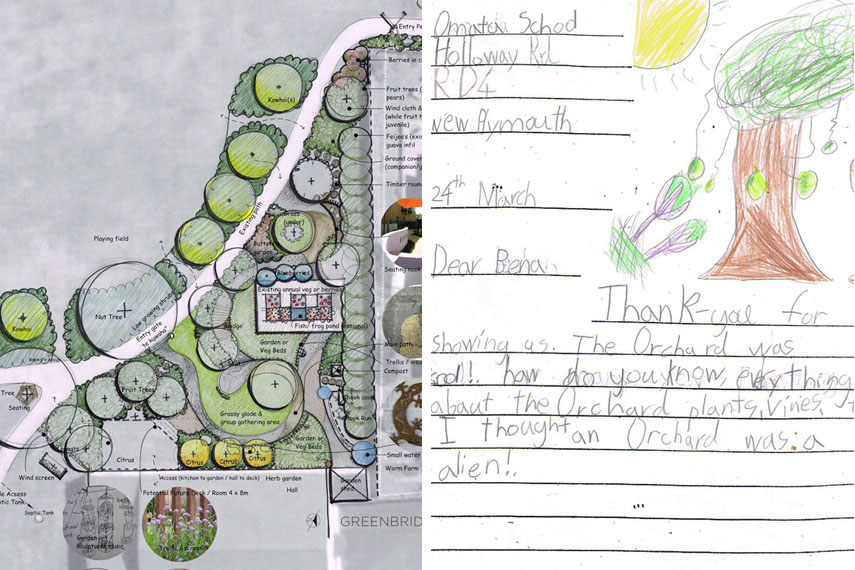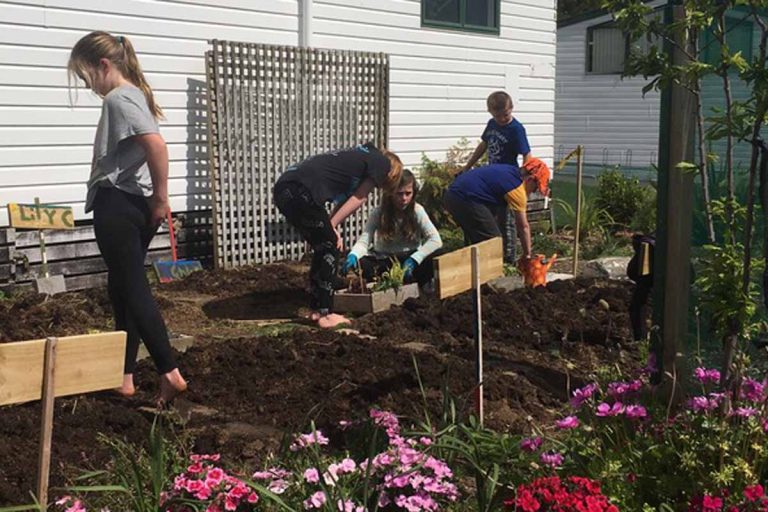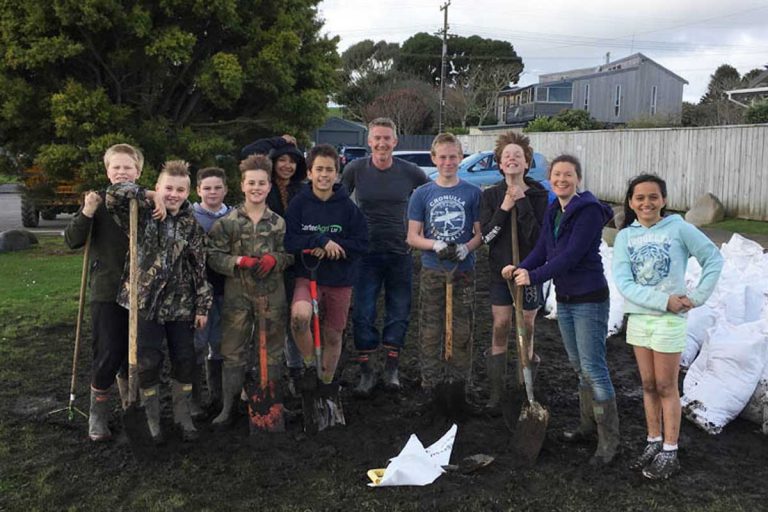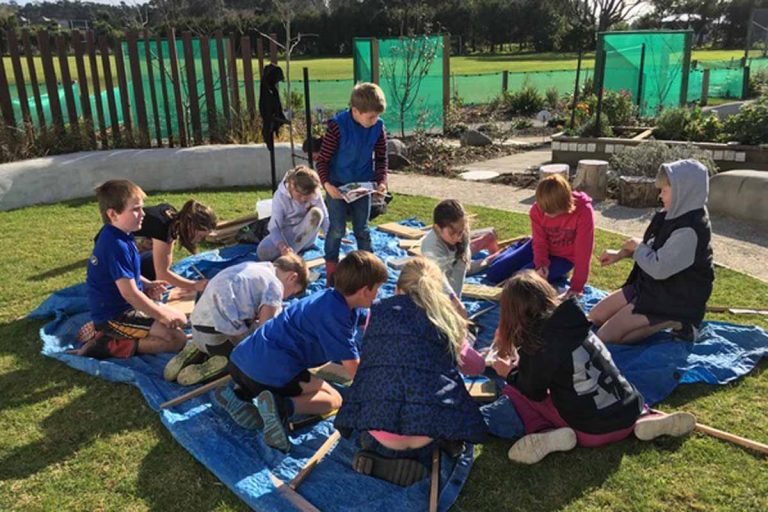Omata School & Community Orchard
Lessons learnt in the design and install of Omata School and Community Orchard, in a nutshell…writes Bena Denton.
The statement of purpose for the Omata Orchard and Food Forest is; a sustainable, visually enticing, accessible space where children and community can connect with nature and nutrition. This was embraced by the whole school as a rich topic, whereby the project was child-driven, based around hands-on authentic learning and linked back to the curriculum in the classroom. In 2016, Karen Brisco (Principal of Omata School, Taranaki) formed a parent group to help install a school orchard. The project quickly evolved, as a larger learning opportunity was identified and Bena Denton of Greenbridge then led the project from inception to completion. This involved professional development of the teaching staff by GB, off-site orchard visits, timeframes, budgets, fundraising, and organisational working bees. In 2017 the design, fundraising and phase one of the construction and planting were undertaken. In 2018 phase two of the planting install was completed and the garden club formed to ensure ongoing maintenance and engagement.
Concept Design
Profile
The area allocated to the project is around 600sqm and includes, a shelter belt, orchard (23 large fruit trees, 16 + berry bushes, 5 vines, multiple herb ground covers), veg beds for 12 garden club children, berry avery, chook area, water harvesting tank, outdoor teaching / flexi space that can sit two classrooms, small timber seating nook, flower picking beds, speaking tubes, fedge (food hedge), yellow gecko habitat areas, butterfly garden, plantings for bees and beneficial insects and a winding shell path that meanders through the space inviting relaxing and play alike.
Why?
This project addresses a disconnect with nature and our food sources. The outdoor space is interactive, where children can engage with an edible garden, grow and cook their own food – this in turn creates an awareness of nature, its seasons, inhabitants as well as reinforcing healthy eating. Children have already begun to identify edible plants and try eating new herbs, flowers, and veggies. In the garden club we have made among many other things ‘weed smoothies’, ‘herb teas’ and scrambled eggs from the chooks bounty. The diversity of plants grown in the out door learning area is already attracting bees, a more active soil biology (heaps of worms when there were none before) and we have established gecko friendly areas to attract the rare endemic yellow gecko (we had a gecko expert visited the school). A worm farm has been set up to receive lunch box compostables.
The orchard is based on a ’food forest concept’ of mixed perennial plantings and support species (which imitates the layers of a natural ecosystem as much as possible) and offers a new food growing paradigm to the children and community. There is a large movement worldwide toward ‘urban farming’, micro bio-intensive gardening and community supported agriculture (CSA’s) etc. This orchard / food forest project puts children into contact with these concepts and hopefully aspires children to diversified jobs and careers that will be the future of Taranaki’s Primary Industry. Children readily observe and interact with the edible space and are trailing these different gardening techniques.
Growing’s one’s own food is the largest positive impact an individual can make, in bringing about change on many environmental issues. The children are learning that growing ones food reduces packaging waste (including single-use plastics as your garden is your supermarket), reduces food waste (pick only what you need and composting), reduces food miles (you can walk to your backyard), costs less (especially if you save seed) and provides more healthy, nutrient dense food (with improved ripple effects on our health care system). Children are engaged and feel empowered in their food growing!
Innovative or Collaborative Aspects of the Project
Children co-designed the orchard with their teachers’ support and with the expertise of local ecological landscape business Greenbridge.
By engaging experts, children could also see this work is a viable career choice. Children were heard, and their ideas directly incorporated like the speaking tube, whimsical curved seating and mosaic concrete as well as many popular fruit and berry trees. This process was ‘messy’ at times and took a whole year but was rich in learning!
Orchard as a play space…to further encourage and engage children in the food garden, it was decided to allow the area to also be a play space and permissible space ie children can run and jump, eat food when they like and just hang out – it is well used.
Whanau groups were often organised for activities, whereby different ages buddied up to help each other.
Collaboratively the orchard was sponsored and established with community funds, expertise and hands.
Trouble Shooting
With a project of this calibre, there are always a few issues to troubleshoot! Leading the teachers, community and children through a complex design and install process that has so far spanned two years has taken patience, big-picture thinking, and determination – but the children’s engagement has made it worth it, as have the teachers commitment and positive feedback Kikuyu was a large initial problem and was tackled by a combo of carpet mulched directly over the kikuyu and black plastic pinned in place for 6 months. Both were successful but meant we had to delay shrub planting and smaller under plantings until eradicated. However, it was an organic approach, so no sprays used in the children food growing areas! Not all of the Board of Trustees saw the learning opportunities in the project initially, but once in place the orchards value to the school was obvious to all.
Joys/ Successes
Part of the Food Garden and Orchard’s success was due to the teacher’s commitment and enthusiasm – it helps to have one passionate lead teacher, in this instance Vicky Aylward. Additionally, GreenBridge was intrinsic to the success of such a tenacious project. While there are many approaches to get a project of this size and scope undertaken, one person, in this instance Bena Denton, donated time, passion, knowledge, and leadership to help see it through. Alternatively, a team of parent community could share these tasks and responsibility.
Garden Club and Ongoing Sustainability of the Project
In addition to each classroom responsible for an area of the orchard (fruit trees, worm farm, compost etc), two children from each room are released from class to spend Thursday afternoons in the garden. The main objectives of the garden club are; to have fun in the garden, connect with nature and do activities that broaden the children’s eco-literacy. This ranges from harvesting calendula drying it and making gardeners balm as gifts to frog ponds to wild weed walks identifying ‘weeds’ that can be eaten and those that can’t. Children are engaged, excited and often comment its so fun to be ‘not learning’ Ha! Regenerative practice by stealth.
GreenBridge Profile
GreenBridge is a multi-award-winning business that specialises in sustainable design for homes and landscapes. Based in Taranaki the three-person social enterprise was established seven years ago by Daniel Woolley and Bena Denton and soon joined by Kama Burwell to offer a range of permaculture and ecological solutions for landscape regeneration, healthy (non-toxic) small footprint homes and community resiliency projects. The road has not been an easy one, but passion, belief, and doggedness now has GreenBridge working on local and national projects, from small backyards to large community projects such as lead designers for the New Plymouth Community Resource Recovery Centre (supported and funded by local government) to Mt White Station in the top of the South Island – all have sustainability at their heart.
Recent Awards: ‘Environmental Leadership in Businesses 2018’ and ‘Silver Best Small Footprint Home New Zealand 2017’






